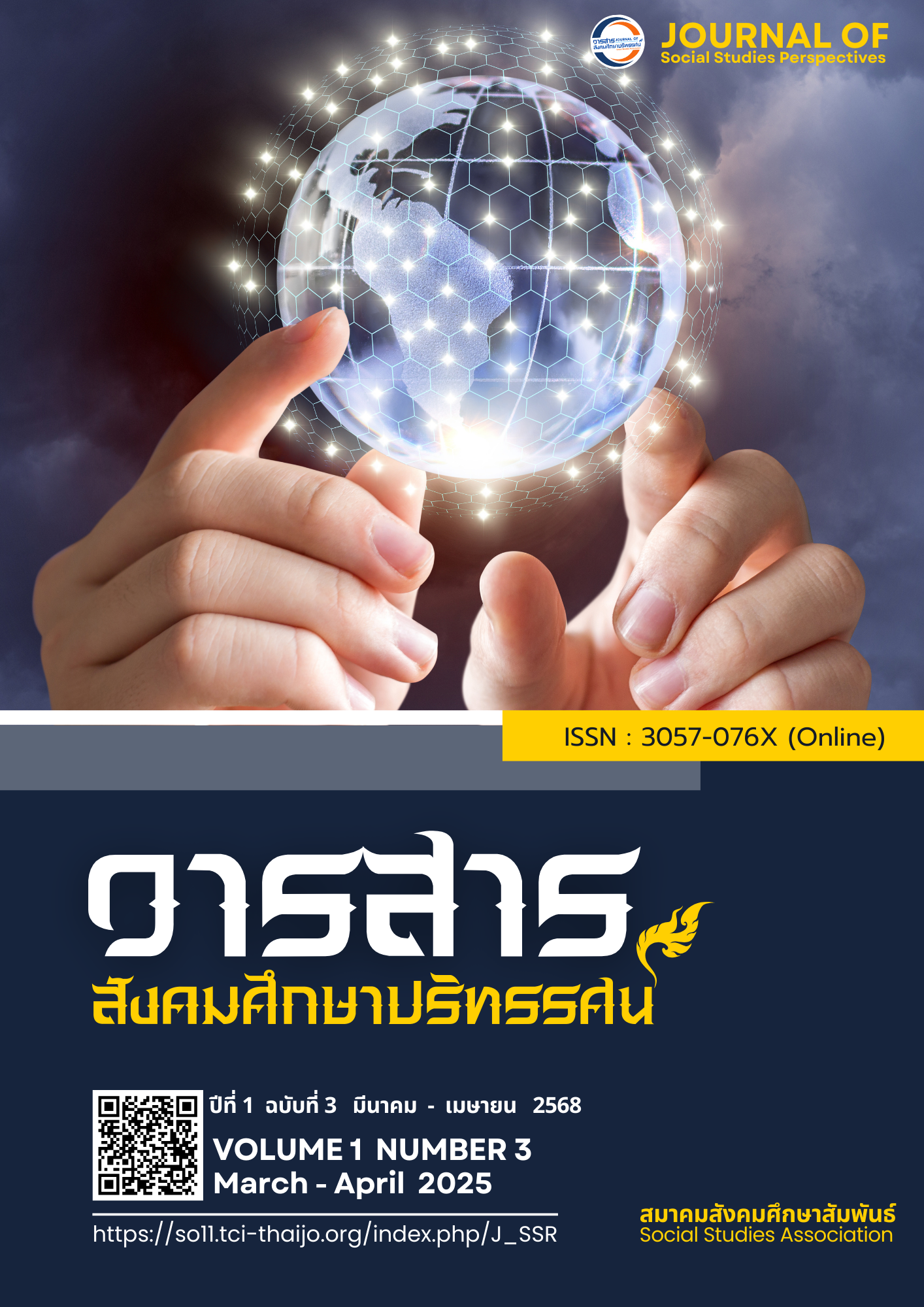เทคโนโลยีอัจฉริยะบิดดีเฟนเดอร์ สคามิโอ เพื่อเสริมสร้างความปลอดภัย ในโลกไซเบอร์ของผู้เรียนยุคดิจิทัล
DOI:
https://doi.org/10.64186/jsp1284คำสำคัญ:
เทคโนโลยีอัจฉริยะ, บิดดีเฟนเดอร์ สคามิโอ, ความปลอดภัยในโลกไซเบอร์, ผู้เรียนยุคดิจิทัลบทคัดย่อ
เทคโนโลยีอัจฉริยะบิดดีเฟนเดอร์ สคามิโอ เป็นโปรแกรมที่สามารถนำมาประยุกต์ใช้ในการเสริมสร้างความปลอดภัยในโลกไซเบอร์ให้กับผู้เรียนยุคดิจิทัลได้ ทั้งนี้เนื่องจากการใช้งานอินเทอร์เน็ตได้ทวีเพิ่มขึ้นอย่างรวดเร็ว การรู้ดิจิทัล การใช้เทคโนโลยีสารสนเทศและการสื่อสารอย่างปลอดภัย การจัดการ การรู้เท่าทันสื่อนวัตกรรมและผลกระทบของเทคโนโลยีสารสนเทศและการสื่อสารต่อการดำเนินชีวิต อาชีพ และสังคม การโจมตีทางไซเบอร์ที่ซับซ้อนและหลากหลายรูปแบบทำให้ผู้ใช้อินเทอร์เน็ตต้องเผชิญกับความเสี่ยงในการถูกหลอกลวงผ่านอีเมล ข้อความ และลิงก์ต่าง ๆ ซึ่งโปรแกรม บิดดีเฟนเดอร์ สคามิโอ ถูกพัฒนาเพื่อช่วยตรวจจับการหลอกลวงออนไลน์โดยใช้ปัญญาประดิษฐ์ (AI) วัตถุประสงค์คือช่วยให้ผู้ใช้สามารถส่งเนื้อหาที่น่าสงสัยสามารถให้โปรแกรมวิเคราะห์และรับคำตอบภายในไม่กี่วินาที ดังนั้นถ้านำบูรณาการในการจัดการเรียนการสอนในตัวชี้วัดที่เกี่ยวข้องกับการรักษาความปลอดภัยทางไซเบอร์ สามารถนำไปเป็นกรณีศึกษาโดยการระบุและป้องกันภัยคุกคามที่อาจเกิดขึ้นจากการใช้งานอินเทอร์เน็ต นอกจากนี้ บิดดีเฟนเดอร์ สคามิโอ ไม่เพียงแต่ช่วยในการตรวจจับภัยคุกคาม แต่ยังส่งเสริมให้ผู้เรียนมีความรับผิดชอบและจริยธรรมในการใช้งานเทคโนโลยีดิจิทัล โดยมุ่งหวังให้ผู้เรียนสามารถเรียนรู้และสื่อสารออนไลน์ได้อย่างปลอดภัยในโลกที่เต็มไปด้วยความอันตรายทางไซเบอร์
เอกสารอ้างอิง
Diteeyon, W. (2024). Approaches for enhancing cyber security among learners. Academic Journal of Thailand
National Sports University, 16, 291-302.
Electronic Transactions Development Agency. (2021). CS101 Basics of Cyber Security. Retrieved December 2,
, from https://www.etda.or.th/th/Useful-Resource/Knowledge-Sharing/Articles/Cybersecurity-
aspx
Fasulo, P. (2021). What is the CIA trait? Definition, importance, & example. Retrieved December 2, 2024, from
https://securityscorecard.com/blog/what-is-the-cia-triad/
Hoanca, B., & Mock, K. J. (2020). Artificial intelligence-based cybercrime. In M. Khosrow-Pour (Ed.),
Encyclopedia of Criminal Activities and the Deep Web (2020, pp. 36-51).
Khurunun, K., & Saengthongdee, T. (2023). Guidelines for preventing cybercrime in Thailand. Journal of Legal
Entity Management and Local Innovation, 9(6), 180-190.
Mailmaster. (2024). Bitdefender (Antivirus Software). Retrieved December 2, 2024,
Na Pibul, A. (2023). The correlations between the concept of cybersecurity and the personal data protection
law. Nitipat NIDA Law Journal, 12, 84-107.
Novak, D. (2024). Bitdefender Scamio – Scam Detector (REVIEW). Retrieved December 2, 2024, from
https://www.linkedin.com/pulse/bitdefender-scamio-next-gen-ai-powered-scam-detector-chatbot-
novak-mf8fc
Office of the Basic Education Commission. (2023). Unhealthiness. Retrieved December 2, 2024, from
https://main.spmnonthaburi.go.th/wp-content/uploads/2024/04/ไซเบอร์.pdf
Pansuwan, C., & Chitsawang, S. (2023). Guidelines on corporate governance for responding to cybersecurity
threats in the digital age. Rajapark Journal, 17(53), 103-119.
Putwattana, P. (2021). Learning management for developing learners in the digital age. Journal of Learning
Innovation and Technology, 1(2), 1-10.
SOSECURE. (2024). Summary of 9 major cyber attacks in Thailand. Retrieved December 2, 2024, from
https://www.sosecure.co.th/en/activity/cyber-attack
SafetyDetectives. (2025). Bitdefender Review 2025: Is it a good antivirus? Retrieved January 2, 2025, from
https://th.safetydetectives.com/best-antivirus/bitdefender/
Thaihealth. (2024). Thaihealth collaborates with Chulalongkorn University's Faculty of Economics to delve
into online threats, revealing that 36 million Thais have been scammed, resulting in nearly 50 billion
baht in losses. Retrieved December 2, 2024, from https://www.thaihealth.or.th/?p=362488
ดาวน์โหลด
เผยแพร่แล้ว
รูปแบบการอ้างอิง
สัญญาอนุญาต
ลิขสิทธิ์ (c) 2025 วารสารสังคมศึกษาปริทรรศน์

อนุญาตภายใต้เงื่อนไข Creative Commons Attribution-NonCommercial-NoDerivatives 4.0 International License.
บทความนี้ได้รับการเผยแพร่ภายใต้สัญญาอนุญาต Creative Commons Attribution-NonCommercial-NoDerivatives 4.0 International (CC BY-NC-ND 4.0) ซึ่งอนุญาตให้ผู้อื่นสามารถแชร์บทความได้โดยให้เครดิตผู้เขียนและห้ามนำไปใช้เพื่อการค้าหรือดัดแปลง หากต้องการใช้งานซ้ำในลักษณะอื่น ๆ หรือการเผยแพร่ซ้ำ จำเป็นต้องได้รับอนุญาตจากวารสาร










